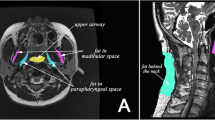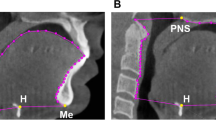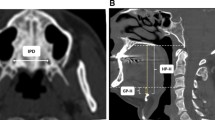Abstract
Objectives
The exact pathophysiology leading to pharyngeal collapse in obstructive sleep apnea syndrome (OSAS) remains incompletely understood. Prior research has shown that normal men have a longer pharyngeal airway than women, and it has been hypothesized that this difference may play a role in the gender-related differences in OSAS. In the current study, we sought to study the potential relationship between the length of the collapsible pharyngeal segment, the upper airway length (UAL), and the severity of OSAS.
Study design
The hospital records were searched for all patients who had had polysomnography and also had had a computed tomography of the neck. A total of 24 such patients were identified who participated (15 men and nine women).
Measurements and results
The UAL, the distance between the lower posterior part of the hard palate bone to the upper posterior part of the hyoid bone, was measured for all participants in the midsagittal plane. A correlation coefficient (Pearson r) of 0.406 was found between Respiratory Disturbance Index (RDI) and UAL (p = 0.049). When UAL was normalized to body height, a correlation coefficient (r) of 0.423 was found (p = 0.039). A gender-related difference in UAL was also found. Men with OSAS were found to have longer UAL even when normalized to body height (p = 0.003, unpaired t test) as compared with OSAS women.
Conclusion
This study provides potential clinical relevance to prior studies in normal subjects, by demonstrating that men with OSAS have longer UAL than women with OSAS, independent of body size. In addition, the significant correlation between UAL and OSAS severity suggests that UAL may play a role in the pathophysiology of OSAS. These findings are consistent with our predictions from computational modeling studies.



Similar content being viewed by others
References
Teran-Santos J, Jimenez-Gomez A, Cordero-Guevara J (1999) The association between sleep apnoea and the risk of traffic accidents. Cooperative Group Burgos-Santander. N Engl J Med 340:847–851
Pepperell J, Ramdassingh-Dow S, Crosthwaite N, Mullins R, Jenkinson C, Stradling JR, Davies RJ (2002) Ambulatory blood pressure after therapeutic and subtherapeutic nasal continuous positive airway pressure for obstructive sleep apnoea: a randomised parallel trial. Lancet 359:204–210
Shahar E, Whitney CW, Redline S, Lee ET, Newman AB, Javier Nieto F, O’Connor GT, Boland LL, Schwartz JE, Samet JM (2001) Sleep-disordered breathing and cardiovascular disease: cross-sectional results of the Sleep Heart Health Study. Am J Respir Crit Care Med 163:19–25
Tarasiuk A, Greenberg-Dotan S, Brin YS, Simon T, Tal A, Reuveni H (2005) Determinants affecting health-care utilization in obstructive sleep apnea syndrome patients. Chest 128(3):1310–1314
Malhotra A, White PD (2002) Obstructive sleep apnoea. Lancet 360(9328):237–246
Haponik EF, Smith PL, Bohlman ME, Allen RP, Goldman SM, Bleecker ER (1983) Computerized tomography in obstructive sleep apnea. Correlation of airway size with physiology during sleep and wakefulness. Am Rev Respir Dis 127(2):221–226
Schwab RJ, Gupta KB, Gefter WB, Metzger LJ, Hoffman EA, Pack AI (1995) Upper airway and soft tissue anatomy in normal subjects and patients with sleep-disordered breathing. Significance of the lateral pharyngeal walls. Am J Respir Crit Care Med 152(5 Pt 1):1673–1689
Avrahami E, Englender M (1995) Relation between CT axial cross-sectional area of the oropharynx and obstructive sleep apnea syndrome in adults. Am J Neuroradiol 16(1):135–140
Yucel A, Unlu M, Haktanir A, Acar M, Fidan F (2005) Evaluation of the upper airway cross-sectional area changes in different degrees of severity of obstructive sleep apnea syndrome: cephalometric and dynamic CT study. Am J Neuroradiol 26(10):2624–2629
Caballero P, Alvarez-Sala R, Garcia-Rio F, Prados C, Hernan MA, Villamor J, Alvarez-Sala JL (1998) CT in the evaluation of the upper airway in healthy subjects and in patients with obstructive sleep apnea syndrome. Chest 113(1):111–116
Malhotra A, Huang Y, Fogel RB, Pillar G, Edwards JK, Kikinis R, Loring SH, White DP (2002) The male predisposition to pharyngeal collapse: importance of airway length. Am J Respir Crit Care Med 166(10):1388–1395
Ronen O, Malhotra A, Pillar G (2007) The influence of gender and age on upper airway length during development. Pediatrics 120(4):e1028–e1034
Malhotra A, Huang Y, Fogel R, Lazic S, Pillar G, Jakab M, Kikinis R, White DP (2006) Aging influences on pharyngeal anatomy and physiology: the predisposition to pharyngeal collapse. Am J Med 119(1):72.e9–14
Rama AN, Tekwani SH, Kushida CA (2002) Sites of obstruction in obstructive sleep apnea. Chest 122(4):1139–1147 Review
Huang Y, Malhotra A, White DP (2005) Computational simulation of human upper airway collapse using a pressure-/state-dependent model of genioglossal muscle contraction under laminar flow conditions. J Appl Physiol 99(3):1138–1148
Ekstrom RE (1963) Buckling of cylindrical shells under combined torsion and hydrostatic pressure. Exp Mech 3:192–197
Huang Y, White DP, Malhotra A (2005) The impact of anatomic manipulations on pharyngeal collapse: results from a computational model of the normal human upper airway. Chest 128:1324–1330
Woodson BT, Conley SF (1997) Prediction of uvulopalatopharyngoplasty response using cephalometric radiograph. Am J Otolaryngol 18(3):179–184
Woodson BT, Conley SF, Dohse A, Feroah TR, Sewall SR, Fujita S (1997) Posterior cephalometric radiographic analysis in obstructive sleep apnea. Ann Otol Rhinol Laryngol 106(4):310–313
Sher AE, Schechtman KB, Piccirillo JF (1996) The efficacy of surgical modifications of the upper airway in adults with obstructive sleep apnea syndrome. Sleep 19(2):156–177 Review
Pillar G, Malhotra A, Fogel R, Beauregard J, Schnall R, White DP (2000) Airway mechanics and ventilation in response to resistive loading during sleep: influence of gender. Am J Resp Crit Care Med 162:1627–1632
Brooks LJ, Strohl KP (1992) Size and mechanical properties of the pharynx in healthy men and women. Am Rev Respir Dis 146(6):1394–1397
Brown IG, Zamel N, Hoffstein V (1986) Pharyngeal cross-sectional area in normal men and women. J Appl Physiol 61(3):890–895
Author information
Authors and Affiliations
Corresponding author
Rights and permissions
About this article
Cite this article
Segal, Y., Malhotra, A. & Pillar, G. Upper airway length may be associated with the severity of obstructive sleep apnea syndrome. Sleep Breath 12, 311–316 (2008). https://doi.org/10.1007/s11325-008-0191-9
Received:
Revised:
Accepted:
Published:
Issue Date:
DOI: https://doi.org/10.1007/s11325-008-0191-9




